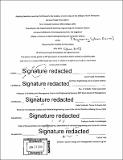Applying machine learning techniques to the analysis of policy data of the military health enterprise
Author(s)
Plmanabhan, Jaya Prasad
DownloadFull printable version (38.50Mb)
Other Contributors
Massachusetts Institute of Technology. Engineering Systems Division.
Advisor
Roy E. Welsch and Peter Szolovits.
Terms of use
Metadata
Show full item recordAbstract
It is common practice in organizational research to apply policy analysis to better understand how an enterprise is approaching and addressing a particular topic of interest. The approach to policy analysis commonly used is known as the Coding Approach. The Coding Approach is a highly qualitative process that involves the manual identification of relevant policy documents, the manual review of these documents to identify the key features of the topic, and the manual identification of the significance of these features as it relates to the policy documents. This process can generates rich insights into policies and how the topic of interest is being approached and viewed by the Stakeholder of the enterprise. This process however is a manually intensive process and is subject to the bias of the expert/s reviewing and analyzing the documents. My study proposes a new approach towards policy analysis that uses the Coding Approach as its template, but applies Machine Learning Techniques, such as Natural Language Processing and Data Mining Algorithms, together with a highly structured form of Case and Cross Case Analysis to identify documents that are related to the topic of interest, to categorize these documents, to surface the key features of the topic, to calculate the significance of these features as reflected by the documents and to draw inferences about the key features and its significance as it relates to the policy documents. This new approach provides a mixed methods approach that marries the best of both quantitative and qualitative techniques towards document analysis. This approach also reduces the amount bias that can be injected from the experts analyzing the documents, and thus guarantees an almost consistent result from document analysis regardless of the experts performing the analysis. For my study I applied my mixed methods approach to analyzing the policy documents of the Military Health Enterprise MHS, to understand how well the MHS 's policies were addressing the delivery of psychological services to service members and their families. This study is important to the MHS for two reasons. With the reductions of the US Military presence in Afghanistan and Iraq there are large numbers of veterans returning who may have various forms of PTSD, who will requires varying types and levels of care. The other reason why this study is important to the MHS is due to the recent scandals (Walter Reed, 2007 & VA, 2014) it has faced specifically around to the health care services it was supposed to provide to service members. Now its crucial for the MHS to understand the disconnect between its policies and what's actually being implemented. This study will provide the MHS with a non-bias review of what are the features of significance from a policy point of view in regards to the delivery of psychological services to service members and their families.
Description
Thesis: S.M. in Engineering and Management, Massachusetts Institute of Technology, School of Engineering, System Design and Management Program, Engineering and Management Program, 2015. Thesis: S.M., Massachusetts Institute of Technology, Department of Electrical Engineering and Computer Science, 2015. Cataloged from PDF version of thesis. Includes bibliographical references (pages 150-154).
Date issued
2015Department
Massachusetts Institute of Technology. Engineering and Management Program; System Design and Management Program.; Massachusetts Institute of Technology. Department of Electrical Engineering and Computer SciencePublisher
Massachusetts Institute of Technology
Keywords
Engineering and Management Program., System Design and Management Program., Electrical Engineering and Computer Science., Engineering Systems Division.